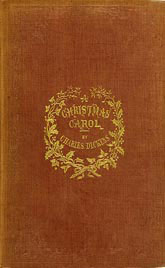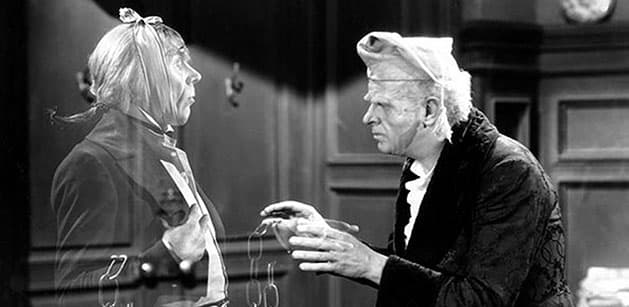A Christmas Carol
Critique • Text • At the movies
 First edition
First editionOriginal title
A Christmas Carol. In Prose. Being a Ghost Story of Christmas.
First publication
1843
Literary form
Novella
Genres
Literary
Writing language
English
Author's country
England
Length
Approx. 28,000 words

Reginald Owen's Scrooge, right, confronts Loe G. Carroll's sleepy ghost of his partner Marley.
Scrooge-lite entertains
A Christmas Carol (1938): Fiulm, 69 minutes; director Edwin L. Marin; writ. Hugo Butler; featuring Reginald Owen, Gene Lockhart, Kathleen Lockhart, Ann Rutherford, Leo G. Carroll
That first big North American production was MGM's 1938 A Christmas Carol, made in trepidation that it wouldn't have legs. But it turned out to be a big hit and, ever since, producers have been making holiday-themed fare every year.
MGM made the story as palatable as possible to the general public. It's lighter and more cheerful than most later takes. Veteran character actor Reginald Owen (see his earlier Sherlock Homes) stepped in to replace a sick Lionel Barrymore in the Ebenezer Scrooge role—and he is very good in a stately and restrained manner, overcoming his corny old-man makeup with its obvious bald wig and pasted-on eyebrows.
The script however never really lets us see what turned the neglected little boy into the archetypical cynic. The Spirit of Christmas Past (18-year-old Ann Rutherford on her way to becoming a major Hollywood star) never shows Scrooge's early money grubbing nor his ill-fated romance as a young man. With the film running barely 70 minutes, his initial conversion to crank and later to good fellow are both too quick.
A pathos-enhancing plot innovation though is to have Bob Cratchit actually fired for unintentionally knocking Scrooge's hat off with a snowball. Cratchit, portrayed by Gene Lockhart, is afraid to spoil Christmas by telling his wife, played by real-life spouse Kathleen Lockhart. (The acting family is completed with a Cratchit daughter played without credit by their real-life child June Lockhart, in her debut before going on to become a movie and television mainstay, starring in the Lassie and Lost in Space series.)
Child actor Terry Kilburn drew praise for his cheery Tiny Tim back then but today he seems too precious, even creepy. And Scrooge's nephew Fred (Barry MacKay) is just too good-natured—why does he bother keeping up with the insufferably rotten Scrooge?
Even the shade of Scrooge's long-dead partner, Marley, is not so scary. He's on screen for a only a few moments and the stalwart Leo G. Carroll plays him as if about to fall asleep forever (although the special effects are pretty good for the time).
The religious aspect, not a big part of Dickens' work, is also played up wherever possible.
The biggest disappointment for Christmas Carol lovers though may be that the morning-after scene in the office, when Scrooge surprises Cratchit with his new disposition, is dispensed with. Instead the former miser delivers the turkey himself to the Cratchit family for the big revelation at their house. But then we need this scene, don't we? Since he'd previously fired Cratchit, there could be no at-work reconciliation. In my view it works well here, though some disagree.
Overall the film is brighter than later versions. Although the setting is still pre-Victorian London, many aspects seem characteristic of American costume films in the 1930s—the sets, like Scrooge's mansion or his boyhood school are bright, airy and grandiose. But still A Christmas Carol is an honest and entertaining first effort.
— Eric

